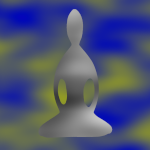Dear Friends,
In Afternoon Instructions – Mindfulness of Mind, Jill looks at different mental processes and leads a reflective practice for the participants.
Jill speaks again about the “wheel” model of how body and breath are related to getting lost in proliferation. It might look something like this:

Here’s how Jill explains this:
To continue exploring the model of the wheel that I brought in at the beginning of the retreat, based on Gil Fronsdal’s teaching, where we can think of the breath and the body as being at the center, at the hub of the wheel. And at the outer rim, when there’s no mindfulness, is proliferation, that habit of getting caught in unhelpful mental activity and reactivity. …
How is it that we move so quickly from the simplicity of the breath to spinning out in loop, after loop, after loop of reactivity? …
As we move out from the center of the wheel, from the breath and the body, we come to the sense contacts and the feeling tones, as the sort of next layer out. … If there’s no mindfulness, we move from there into mental reactivity – into liking, disliking, or spacing out. …
We tend to identify with our experiences – to take them personally, to have them define me, mine, who I am. …
We need to develop this same quality of non reactive awareness to all of our mental activity as well, so that we can stay present with our thoughts, our emotions, our moods, our mind states.
Then she describes how she defines these types of mental activity.
Thoughts – any kind of mental process – might be verbal, visual, or auditory types of thoughts.
Emotions – similar to how the word is used in English – a compound of physical and mental experiences. Without mindfulness, there can be a feedback loop between the thoughts and body sensations that help an emotion to stick around longer. Emotions come and go.
Moods – are more in the background, coloring our experience. They tend to not move as fast as emotions, and they can be harder to see. If we do investigate a mood, we may see that it’s a layered experience of several emotions.
Mind states (or mental qualities) – are things that aren’t easily classified as thoughts, emotions, or moods. Jill gives examples like: is the mind alert or dull, concentrated or distracted, interested or not engaged, etc.
To work with thoughts, emotions, and moods, Jill invites three questions:
- What’s happening in the body?
- What’s happening in the heart mind?
- How am I relating to the experience?
These questions can re-ground us in the body/heart/mind and help us move from the outer rim of proliferation and reactivity back to a mindful, kind, compassionate relationship with the experience.
The dyad activity that she invites people to do is an out loud naming of what’s happening in the mind, just with a word or two, allowing space for something to arise. In my experience of doing this type of practice, the out loud brief naming helps slow down the process a bit, so I’m less likely to jump into a long story. As a solo practice, I find that doing this as a written exercise can work – because it invites a bit of attention and slowing.
I might write things like: worry, planning, auditory thought, quietness, curiosity, sadness, anticipation, calm, not knowing. Set a timer for 3 minutes, settle into the body and breath, when a thought, emotion, mood, or mind state, write it down. Allow yourself to center back to the body and breath, and notice what’s next.
You can also do this type of practice in meditation – paying attention to how emotions are experienced in the body, and/or labelling them.
Chris Germer has a couple of 10-minute practices on his website:
- Mindfulness of Emotions in the Body
https://chrisgermer.com/wp-content/uploads/2020/11/MindfulnessofEmotionintheBody.mp3 - Labeling Emotions
https://chrisgermer.com/wp-content/uploads/2020/11/LabelingEmotions.mp3
The idea of any of these types of practice is to build the capacity to be with these more ephemeral parts of our experience without being pulled out into habitual reactivity. The body/heart/mind can learn what our habits are, what leads us away from ease and peace, and what is skillful.
With patience, kindness, curiosity, and care, we are cultivating the conditions for wisdom to arise.
I’m interested to hear if you tried any of the practices (written, noting, or something else), and what you discover!
With best wishes,
Andrea

Thanks for this AG
Reminds me that the purification of my being does not come without intent and that intent mandates work and repetition and re-dedication and does not arrive unbidden on a silver platter. It must be sought, desired without clinging or striving. Practice is not a noun it is a verb.
RND